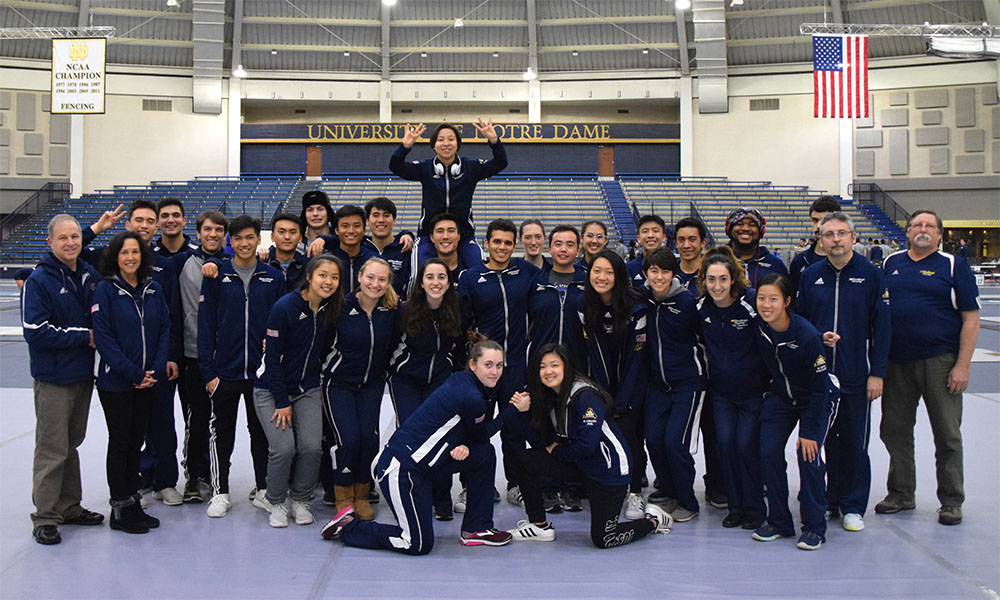
The UCSD Triton Fencing Team after the Northwestern Duals at Notre Dame (Feb. 3, 2018). Photo: Gary Okamoto
“College fencing is different,” my collegiate friends explained to me as I began the fencing recruitment process. “How could college fencing be different from regular fencing?” I wondered. The sport is pretty straightforward: you fence to five in pools and fifteen in DEs, maybe make the finals, and come home either with some lessons learned or shiny hardware (or both!).
However, after my first collegiate tournament, the Western Invitational held at Stanford University, I finally understood what they meant.
I was recruited to fence for the University of California, San Diego in the Spring of 2017. Coming from Swords Fencing Studio in Burbank, California, I knew what hard-work entailed, but was definitely overwhelmed to learn that the UCSD team trains six days per week. The schedule consisted of three days of three-hour practices, two days of hour-long conditioning sessions, and one four-hour long day of practice. (Not every school trains this much. It varies based on whether the school is Division I, II or III and NCAA regulations.) This high caliber of training was definitely an adjustment come the start of the school year (let alone balancing a full course-load!) but there were plenty of reasons that made it worth the time commitment.
1) The people. I lucked out in having an incredibly supportive team that I loved spending time with. The hours were long, but they did not feel as grueling as they would have if I was not alongside my friends. My teammates became some of my closest companions and go-to people in a new social environment.
2) The exercise. Living healthily in college is hard. The myths of Top Ramen and late nights are 100% true. Having a mandatory time of the day to do exercise is extremely helpful when trying to maintain your beach bod (something that comes particularly handy when living in La Jolla). But really! It’s easier to be sedentary than active in college without some sort of motivation.
3) An outlet. Days are busy, work piles up, and life gets stressful, but fencing allowed me a time to put all that aside, and focus on my improvement in the sport. I have found that variety in activity is key to living an emotionally healthy life.
4) The time-management lessons. Balancing fifteen hours a week of fencing on top of being a full-time student and participating in other extra-curriculars is a definitely a juggling act, but it also forces you to be mindful about how you spend your time. In addition to fencing, I have managed to be a contributing writer to UCSD’s independent newspaper The Triton and also be part of a band that practices weekly. Never once have I turned in a late assignment. It can be done!
5) An identity. Being a student-athlete immediately gave me an identity on campus. This aspect was especially important to me because I was worried about how I could distinguish myself in a school of 30,000 students. Sometimes just wearing a UCSD Fencing shirt would cause strangers to strike a conversation with me and do that ghastly version of en garde that we all know too well. I felt like I was a part of something important that I could contribute to.
Collegiate Competition
You’ve made it this far; congrats! As a prize, you get the answer to my initial question. What’s different about college fencing? Frankly, it’s the format of the competition paired with the incomparable atmosphere of team spirit. When I entered the Stanford venue alongside my teammates, I felt a sense of pride in being a Triton. The feeling never left me emotionally as I spent the entirety of the competition day fencing my best to represent my team and cheering on my teammates at the top of my lungs.
Structurally, college fencing can best be likened to pool bouts. Most schools select travel teams consisting of their top fencers to compete against other schools. However, if the tournament is nearby, the school may bring their entire team.
Usually, the team will select three fencers to compete against a certain school, but depending on circumstances, fencers can be switched in and out. You fence the other team to the best of nine 5-touch bouts, and rotate who fences in a particular order. The winner is decided when the fifth bout is won, since it represents the majority of the wins. The coach or teammates can also call a time-out in the middle of one of these five-touch bouts if they want to give you advice or think you need a break. Pool bouts may not sound so bad, but when you’re fencing eleven schools the physical exhaustion adds up. Every touch matters. You are not only fighting for yourself, but fighting for your team.
In a match with another school, the winner is determined by the overall amount of wins between the three squads. Men and women are separate. For example, if UCSD women’s epee beats Stanford 9-0, but women’s foil and saber lose to Stanford 2-7, then Stanford has won the match. Sometimes the men can beat the same school that the women lost to or vice versa. Other times there are some schools that only women can fence since they don’t have a male fencing team, (i.e., Wellesley, Northwestern, Cornell, Tufts, Temple, and Wagner).
Another aspect that is unique to college fencing is your “power ranking.” Your power ranking is composed of your letter rating as well as your national/international points. The math behind these rankings is a little too complicated to explain, but your power ranking may affect who your coaches want you to fence. For instance, I am currently a B-rated fencer, so my coaches only wanted me to fence Bs and As. If I fenced a U, regardless of whether I won or lost, my power ranking would go down. The whole power ranking thing can be a bit of a distraction though and only really comes into play at Regionals, so don’t worry too much about it.
Regionals
Once the collegiate competition season nears its end, your teammates become your opponents. In order to decide which fencers will compete in the NCAA Championships, each region holds a regional competition. Every school can send up to 24 fencers (four in each weapon in both genders) if they qualify for regionals. (It’s something along the lines of twenty bouts and a 25% win rate).
The tournament is formatted in a few rounds of pools that slowly eliminate fencers until the final pool is reached. For the Western region, we had one round of pools (3 pools of 5 fencers) and eventually moved on to one bigger pool of nine. You begin by fencing your teammates to get the hard part over with and then proceed to fence everyone else. The amount of qualifiers varies per region, but in mine only two will make it to Nationals. This is where the power rankings come in. If you are seeded much higher than the person that places in front of you at regionals, you have the potential to jump them.
NCAA Championships
Last season I was fortunate enough to be one of the two qualifiers from the west coast to compete in the NCAA Championships for women’s epee held at Penn State in State College, Pennsylvania. Consisting of the 24 best collegiate fencers across the country in both genders for each weapon, I can easily say that it was the most difficult competition of my ten-year fencing career.
The tournament format is 23 pool bouts split into four rounds. Before the tournament begins, everyone is placed into a pod usually of four, and travel through each round of the competition with the same group. When I went, my UCSD teammate and I were put with the two qualifiers from Notre Dame. While not universal, some pods were especially supportive of each other even though they represented different schools. This was also a great opportunity to meet elite fencers from other colleges.
After each round, fencers are seeded based on their win percentage and indicators if they are tied. Following the fourth round, all placements are final except for the top four who fence in direct elimination bouts. From there, the competition proceeds like a normal tournament until the winner is crowned. Those who come in the top 12 also garner “All-American” status which is a testament to their strong performances at the national level.
Final Thoughts
Frankly, I can’t imagine my college experience without fencing. College itself is a difficult transition to make, but having people who ground you and support you makes the process much easier. Moreover, it allows you to think bigger than yourself and push harder than you thought you could for the sake of the team. Plus, all the free stuff (i.e. equipment, clothing, bags, logoed paraphernalia) doesn’t hurt.










Brandon Chien
2018-08-01 at 11:51 PM
Hyped to start my collegiate career now 🙂
Kathryn Atwood
2018-08-02 at 7:18 AM
Emily,
This is a great article. Lots of great info from the inside! And pretty awesome that you were one of the two qualifiers. Congrats! I would love it if you would write an article about the recruitment process. Do’s and Don’ts, when to reach out to coaches, etc.
Edward Kaihatsu
2019-07-10 at 3:02 PM
Emily, this is a really well organized article about college fencing. It is very different from all other fencing and has many benefits to the fencer using this format. I mentor fencers who want to go to university in the USA who live outside of the USA. They will find your insights helpful and inspirational. Thank you so much for putting this in writing. This is very well done.